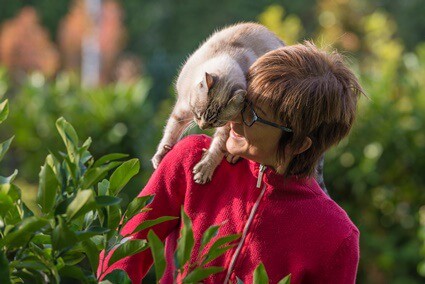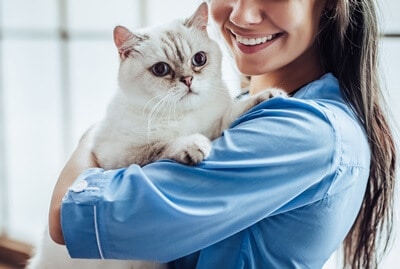Cats rarely display variety in their facial expressions, relying more on body language and vocalizations to communicate with us. Humans are different, relying on facial cues to get a read on a situation.
Cats understand facial expressions, including smiling faces. That’s because cats remember things that matter to them, so they’ll recall that human smiles mean that someone is in a happy, responsive mood. So, your cat will take this opportunity to request food, petting sessions, and play.
If cats can identify smiles and recall what this means about your current state of mind, they can also identify the meaning of frowns and scowls. If you’re upset or crying, a cat may fear that your facial expression is a precursor to an argument, going outside to keep a safe distance.
Do Cats Understand Human Facial Expressions?
As solitary animals who often live alone, cats have a reduced understanding of interactive dynamics. Two cats can communicate using body language, but this becomes more challenging with humans.
You’d be forgiven for assuming cats don’t pay attention to human body language. Cats rarely approach when their name is called and may disregard commands or instructions issued by an owner.
This doesn’t mean that cats refuse to take leads in their behavior from humans. A study published in Animal Cognition confirms that cats seek affirmation from trusted owners before embarking on new experiences, basing their reaction on human encouragement or admonishment.
Interestingly, cats seemingly emphasize facial cues and expressions more than they do verbal commands. Cats don’t necessarily understand what a smile on a human face means, but as per the journal Animals, they can recognize smiles and react based on experience.
In most cases, humans smile when happy, such as spending time with our beloved pets. You’ll likely smile, voluntarily or without realizing it, when interacting with your cat as its behavior amuses you.
This won’t go unnoticed by a cat, so expect them to approach if it sees you smiling. Cats are smart and understand that this is the best time to ask for food, petting, grooming, or play.

Should I Smile at My Cat?
We mentioned that cats notice negative social expressions as acutely as smiles.
If you’re feeling tense, under the weather, or angry, your cat will be able to tell the difference. You may notice your cat watching you from a distance, showing obvious signs of stress.
Pay attention to how your face contorts while you smile, considering how this will appear to a cat. Smiles must be a safe and reliable barometer of human happiness and contentment.
A smile that bares teeth could be misconstrued as a threat by a cat. Even if you have forged a strong bond with your cat, it’ll be nervous and apprehensive around you.
The best way to smile at a cat is to relax your face into a neutral position, narrow your eyes, and spread your lips into a broader, closed-mouth smile.
Close your eyes for a second or two if you feel comfortable doing so. This facial expression will be considered pure affection by a cat, especially if you also slow blink.
How Do Cats React to Human Smiles?
Cats are unpredictable, so there’s no one-size-fits-all feline response to a human smiling.
A cat will respond to an owner’s smile favorably in most cases. Once your cat has spent enough time watching you, it’ll know when you’re in a happy mood.
Some cats will jump into an owner’s lap and purr when they see a human smiling. The cat understands that a human is having a good day, making it more likely that you’ll share this happiness with them.
Of course, this isn’t guaranteed because every cat is unique. Some cats may find smiling intimidating or show indifference to this distinctly human expression.

My Cat Hisses When I Smile
Something is amiss if your cat hisses or runs away from you when you smile. What is supposed to be a reassuring gesture of happiness is instead sparking a fear-based response.
Look in the mirror while you smile. How does this look? Are your teeth bared in a manner that a cat could consider threatening, as though you plan to snarl and bite? This, coupled with unwanted attempts at handling, may frighten a cat.
Other reasons why a cat may react adversely to human smiles include:
- You have taken to smiling to mask anger, disappointment, or frustration. The cat is now associating human smiles with negative emotions.
- You have young children that smile and giggle while unwittingly inflicting pain on the cat, such as pulling its tail.
- The cat was mistreated by somebody that took glee in this questionable behavior, again leading the cat to associate human smiles with impending pain.
- Your cat cannot distinguish between smiling, frowning, scowling, and other facial expressions. This could be because it doesn’t have good eyesight.
Consider pairing your smile with a particular sound, such as lightly tinkling a small bell, to forge an unmistakable emotional connection to smiling.
Why Won’t My Cat Smile Back at Me?
If you wander around smiling, you may grow disheartened that your cat isn’t smiling back. Don’t take this personally, as cats can’t physically smile as their facial muscles don’t allow that expression.
It’s easy to mistake feline cries for help for a smile. If your cat curls its lips or bares its teeth, it may be struggling to mask pain to keep itself safe.
Of course, not all feline body language is related to discomfort. In place of smiling, your cat may display signs of happiness, especially when looking for attention, including:
- Watching you with wide eyes and unnarrowed pupils, especially when followed by a slow blink.
- A high tail that points straight upward or is curled into a question mark shape.
- Rubbing against your legs and feet.
- Following you around and running circles around your feet.
- Presenting toys and asking for playtime.
- Licking you, which is a sign of affection.
If you’ve ever wondered, “do cats know when you smile at them?” you now know that the answer. So, you should make every effort to smile in the company of your cat, provided the emotion is genuine. Cats may not know what smiling means, but they connect human smiles with positive outcomes.


This article is extremely well written, researched and informative! Thank you 😊